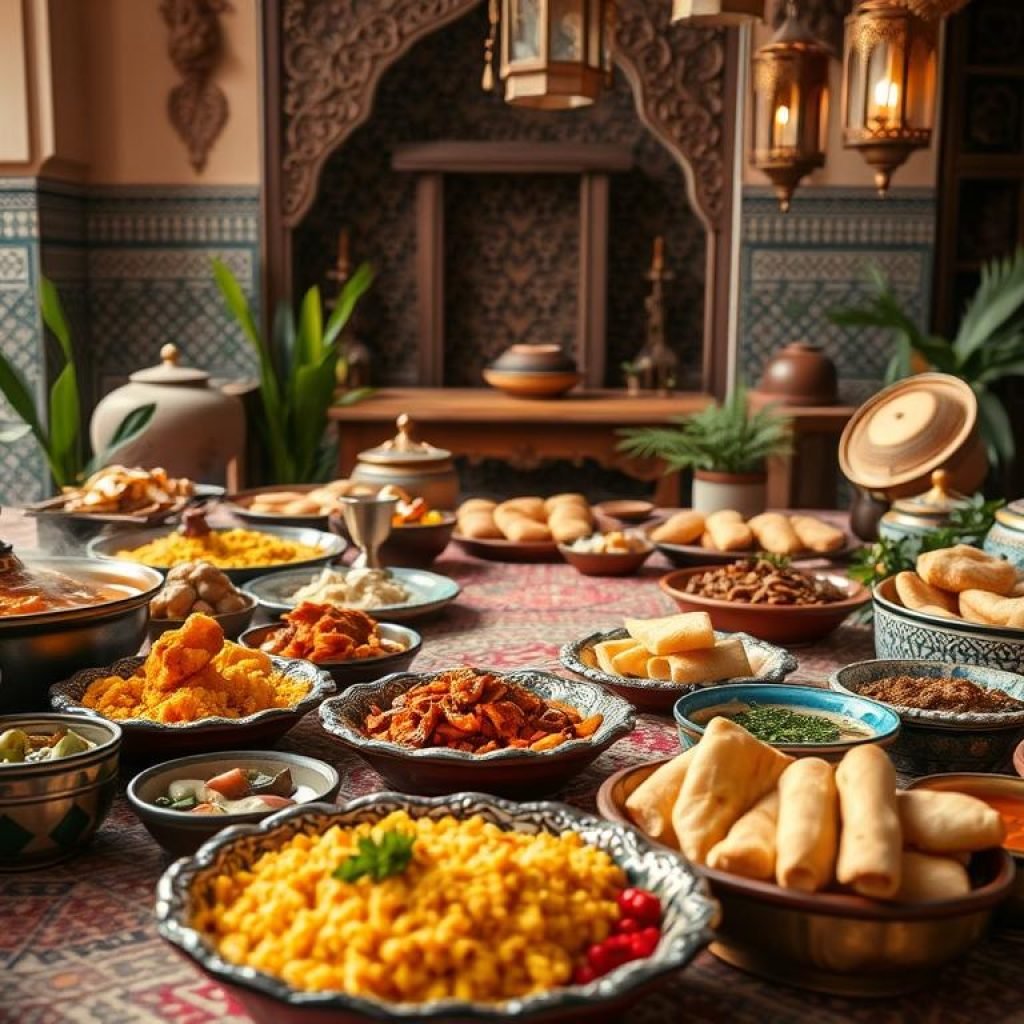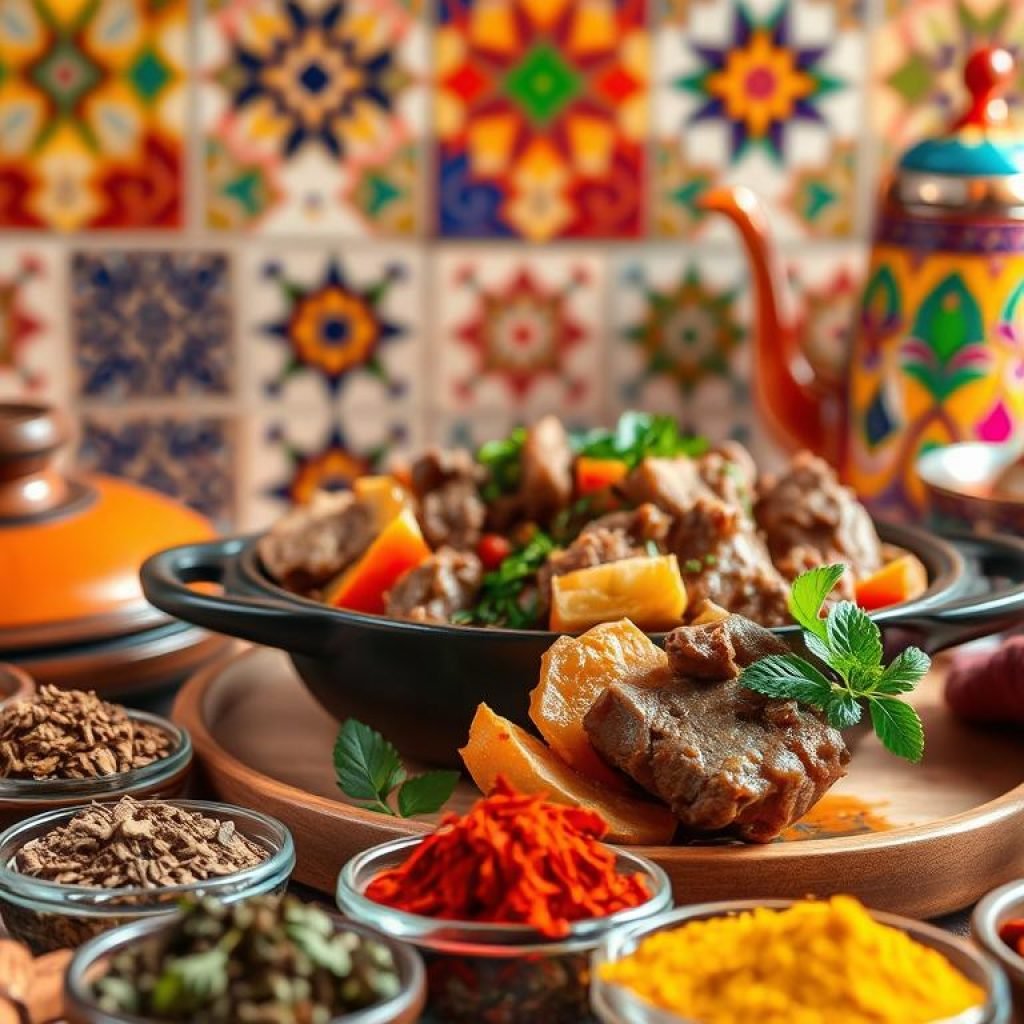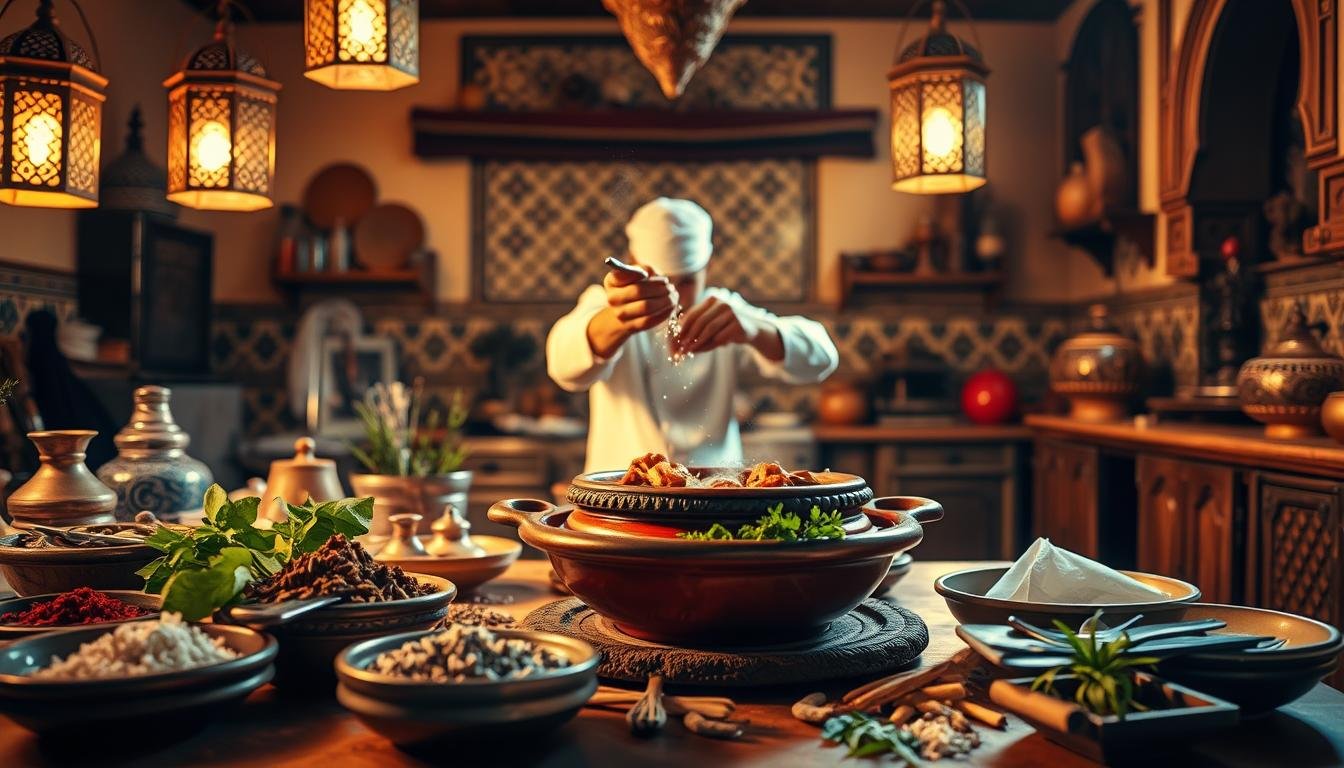Many travelers wonder what to eat in Morocco. But one dish that really stands out is the traditional Moroccan tagine. This slow-cooked stew is a key part of Moroccan cuisine, using meat, vegetables, and spices.
Tagines are special because they’re made in a traditional clay pot. They offer rich flavors and aromas. Cooking a tagine at home is a great way to explore Moroccan cuisine.
Exploring Moroccan cuisine reveals many delicious dishes. From traditional tagines to modern recipes, there’s something for everyone. Moroccan food showcases the country’s rich cultural heritage. So, why not try it out?
Introduction to Tagine Cooking
Cooking a tagine is simple but requires patience and practice. With the right ingredients and a bit of know-how, you can make a delicious Moroccan tagine at home. Each step, from seasoning the clay pot to presenting the dish, is crucial for a memorable experience.
Key Takeaways
- Traditional Moroccan dishes like tagines are a staple of Moroccan cuisine
- Cooking a tagine requires a clay pot and a variety of ingredients, including meat, vegetables, and spices
- The key to a good tagine is slow cooking over low heat
- Tagines can be made with a variety of ingredients, including beef, lamb, and chicken
- Moroccan cuisine is known for its rich flavors and aromas, making it a popular choice for foodies
- Cooking a tagine is a great way to experience the unique flavors and traditions of Moroccan cuisine
What is Moroccan Cuisine?
Moroccan cuisine is a mix of rich flavors and fresh ingredients. It offers a wide range of Culinary delights of Morocco. Influences from Arab, Berber, Andalusi, and Mediterranean cuisines make it unique. The Best food in Morocco is found in local markets and restaurants. Here, you can enjoy traditional dishes like tagines and couscous.
For a true taste of Morocco, try Authentic Moroccan recipes. Chicken tagine with preserved lemons and green olives, or lamb with prunes, are great choices. These dishes highlight the variety of traditional flavors and spices used in Moroccan cooking.
Understanding the History of Moroccan Cuisine
Moroccan cuisine has a long history, dating back to the 7th century BC. Its strategic location has made it a place where different culinary traditions meet. This has influenced the flavors and dishes of Morocco.
The Importance of Spices in Moroccan Cooking
Spices are key in Moroccan cooking. Ingredients like cumin, ginger, and cinnamon add flavor and aroma. The Moroccan spice mix, ras el hanout, has 27 different spices. These are vital to many Moroccan dishes.
Popular Moroccan Dishes
Exploring Eating in Morocco reveals a world of tasty dishes. Moroccan food is famous for its bold flavors and scents. Ingredients like cumin, coriander, and cinnamon play a big role. Tagine, a slow-cooked stew with meat, veggies, and dried fruits, is a standout.
In Moroccan food culture, tagines and couscous are key. Couscous, a semolina flour pasta, is topped with beef or lamb and veggies. Harira, a spiced vegetable soup with chickpeas, and pastilla, a savory pie with meat and spices, are also favorites.

- Tanjia Marrakchia, a signature dish from Marrakech
- Zaalouk, a cooked salad of grilled eggplant and tomatoes
- Msemen, a flaky flatbread often enjoyed for breakfast or as a snack
- Maakouda, crispy potato fritters that are a popular street food
These dishes highlight the variety and depth of Moroccan cuisine. It’s deeply connected to the country’s Moroccan food culture and traditions.
Dining Etiquette in Morocco
Exploring what to eat in Morocco means learning about local dining rules. Moroccan food is famous for its rich tastes and dishes like tagines and couscous. It’s important to respect the mealtime customs and traditions.
Dining in Morocco is a shared experience. Most meals are eaten with family and friends. It’s proper to use your right hand when eating. Also, keep eating to show you enjoy the food. Traditional meals usually have 3 to 5 courses, with tagine being a favorite in 70% of them.
Some key dining etiquette tips in Morocco include:
- Tipping at least 10% in restaurants
- Using the right hand when eating with your hands
- Waiting for the host to begin eating before starting your meal
- Sharing meals with others, as this is a significant part of the culture
By following these customs, you can enjoy Moroccan dishes and culture more. Whether you’re trying what to eat in Morocco or exploring local food, knowing the dining etiquette will make your experience better.
Exploring Marrakech’s Dining Scene
Marrakech is a food lover’s dream, with many restaurants and cafes to try. You can find Authentic Moroccan recipes in traditional spots or modern twists in new places. The Best food in Morocco is found in Marrakech’s lively streets, where spices and fresh ingredients fill the air.
In Marrakech, you’ll find many dining options. Popular Popular Moroccan ingredients like lamb, chickpeas, and veggies are used in dishes like tagine and couscous. For a real taste of Morocco, visit a traditional riad for a meal in a historic setting.
https://www.youtube.com/watch?v=YixNw1FJjo8
Must-try dishes in Marrakech include tagine, couscous, and pastilla. These dishes use Popular Moroccan ingredients like spices, meats, and veggies. For a special meal, try a tasting menu at Azar Restaurant for about $40 per person. Or, enjoy a traditional breakfast at a riad with fresh pastries, homemade jams, and orange juice.
To enhance your dining in Marrakech, follow these tips:
- Avoid touristy spots and opt for authentic, local eateries instead
- Try a variety of dishes, including tagine, couscous, and pastilla
- Don’t be afraid to ask for recommendations from locals or your server
Cooking Moroccan Food at Home
Cooking Moroccan food at home lets you enjoy the culinary delights of Morocco right in your kitchen. Moroccan cuisine is a mix of Arab, Berber, Mediterranean, Andalusian, and southern European flavors. It’s known for its spicy harissa and sweet preserved lemons.
Key ingredients include lamb, couscous, apricots, olives, chickpeas, saffron, and preserved lemons. These help make dishes like tagines, stews, and salads. For instance, a simple bread recipe takes just 15 minutes, and a hearty chickpea stew cooks in under an hour.

To start cooking Moroccan food, stock up on essential spices and ingredients. Here are some tips and techniques to remember:
- Use spices like cumin, saffron, and paprika to flavor your dishes.
- Experiment with different ingredients and flavor combinations.
- Prepare preserved lemons and other staples to add depth to your dishes.
With practice and patience, you can make delicious Moroccan cuisine at home. It’s perfect for cooking for yourself or a crowd. So, why not try it and explore Traditional Moroccan dishes today?
Moroccan Food Culture and Traditions
Moroccan food culture is vibrant and rich. It has many traditions and customs. Mealtimes in Morocco are for bringing people together. The daily rhythm is influenced by five calls to prayer, setting meal times.
Food is key in Moroccan culture. Families often have couscous on Fridays, making it a special dish. Tagine, a thick stew, is eaten for lunch and dinner, showing regional differences.
Some popular dishes include:
- Tagine, a thick stew made with meat, vegetables, and dried fruits
- Couscous, a staple grain dish consisting of tiny steamed balls of semolina
- Bastilla, a savory pie made with shredded chicken or pigeon, almonds, and spices
Hospitality is crucial in Moroccan food culture. Mint tea, called “Moroccan whiskey,” is a staple. It’s served in small glasses, poured high, showing hospitality. When you eat in Morocco, expect a glass of mint tea as a welcome.
Modern Moroccan Cuisine
Modern Moroccan cuisine is a lively and creative scene. It features chefs and restaurants that put a new spin on old dishes. The best food in Morocco
Modern Moroccan dishes often include fresh takes on tagines and couscous. They also use popular Moroccan ingredients like spices, herbs, and olive oil in creative ways. For instance, a modern tagine might mix traditional recipes with a modern twist.
Modern Moroccan cuisine is all about:
- Innovative uses of traditional ingredients
- Blending of traditional and contemporary techniques
- Emphasis on fresh, local ingredients
These elements come together to offer a unique and thrilling dining experience. It highlights the best of Moroccan cuisine.
Moroccan Food and Drink
When exploring what to eat in Morocco, you’ll find endless choices. Moroccan cuisine is famous for its tasty drinks like mint tea and orange juice. In fact, locals and visitors drink Moroccan mint tea 4+ times a day. Breakfast often starts with orange juice and a choice between hot mint tea or coffee.
A traditional Moroccan meal has three parts: appetizers, main dish, and dessert. The main dishes are tajine, couscous, and pastillas. These dishes come with meat like chicken, beef, or kefta. They’re served with khobz, a bread used to scoop up stews.
Looking to try Moroccan cuisine? You have many options, from street food to fancy restaurants. Prices range from $3 to $50 per person. Popular dishes include tagines, couscous, and pastillas. Moroccan cuisine is known for its rich flavors and aromas, making it a must-try in Morocco.
Conclusion
Moroccan cuisine is a world of delicious discoveries. It includes iconic dishes like tagines and couscous. These dishes are known for their unique spice blends and cooking methods.
The variety of Moroccan dishes shows the country’s cultural influences. Flavors range from grilled sardines to hearty mountain tagines. Every bite, from mint tea to pastilla, showcases the region’s culinary artistry.
Moroccan food culture is all about community and tradition. Meals are often shared with others. This makes us appreciate the culinary delights of Morocco and its rich gastronomic heritage.




Comment (0)